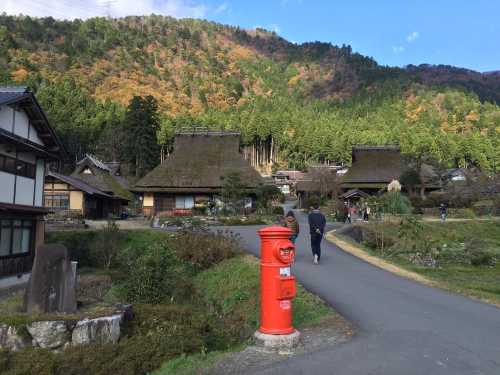Popular Trip Moments
All About Miyama Village, Kyoto 🇯🇵 | Kamakura Shrine Miyama Village, Kyoto 🇯🇵 | A Wonderful Cafe in Kyoto | Miyama kayabuki japan | Miyama folk museum (Thatched-roof houses) | A chill trip to the Japanese countryside - I miss it so much after returning home! | Miyama Kayabuki-no-Sato | Kayabuki No Sato,most stunning in kyoto | Unspoiled Charm of Miyama Village | Snow Lantern Festival in Kyoto | หมู่บ้านคายาบุกิ หมู่บ้านโบราณ ณ.เกียวโต | [Kyoto] The world of Japanese folk tales still remains! Introducing Japan's original landscape spots 🔍 *Access tips included | Miyama Gassho Village (Kyoto Prefecture)
Popular Travel Types
Popular Destinations
Chaozhou Travel | Hoi An Travel | Taichung Travel | Nha Trang Travel | Pulau Perhentian Travel | Kanazawa Travel | Türkiye Travel | Jeddah Travel | Fukuoka Travel | Johor Bahru Travel | New Zealand Travel | Nepal Travel | Seville Travel | Hanoi Travel | Akita Travel | Helsinki Travel | Cairns Travel | Ibusuki Travel | Shenyang Travel | Bastogne Travel | Yining Travel | Jeffersonville Township Travel | Greensburg Travel | McHenry Travel | Walpole Travel | Mold Travel | Rijeka Travel | Gao'an Travel | Tomakomai Travel
Recommended Attractions at Popular Destinations
Bangkok attraction near me | Manila attraction near me | Tokyo attraction near me | Taipei attraction near me | Hong Kong attraction near me | Seoul attraction near me | Kuala Lumpur attraction near me | Los Angeles attraction near me | Shanghai attraction near me | New York attraction near me | Shenzhen attraction near me | Osaka attraction near me | Singapore attraction near me | London attraction near me | Guangzhou attraction near me | San Francisco attraction near me | Beijing attraction near me | Macau attraction near me | Bali attraction near me | Jakarta attraction near me | Paris attraction near me | Ho Chi Minh City attraction near me | Istanbul attraction near me | Phuket attraction near me | Chicago attraction near me | Seattle attraction near me | Toronto attraction near me | Orlando attraction near me | Cebu attraction near me | Chiang Mai attraction near me
Popular Attractions
Magic World Penang | SplashMania WaterPark | Pantai Teluk Buih | Universal Studios Hollywood | Tropical Spice Garden | Zoo Melaka | Bangi Wonderland | Ba Na Hills | Farm In The City | Splash Out Langkawi | Desaru Coast | Colosseum | Situmurun Waterfall | Wake park Mnichovo Hradiště | Alfarooq Mosque | Salzhaff | Masjid Mijahan | Lo Parot | Shiv Mandir Chauri | Sakuragaoka Park | Champagne Sports Resort Golf club | Saraswati Temple | Golden Dome Cabaret Show | SnoWalk by i-City | Sunway Lost World of Tambun | Escape Penang | Dolphins Bay Phuket | Fraser’s Hill (Bukit Fraser) | Chao Phraya River | A' Famosa Water Theme Park
Popular Restaurants in Nantan
Kajikaso | Oshokujidokoro Kitamura | Cafe Miran | Reinbou | Cafe Le Jardin Pop | Vivid | 高原バーベキュー | Cafe Gallery Saika | Sakae | Ikeju | Log Cafe Matatabi | Hakkou-Kan | Juju | Takeyoshi | Cafe Cotton | Tokutoku Kyoto Sonobe Inter | Herbalist Club Miyama | Miyama Suisenan Sai | Namaste Taj Mahal, Sonobe | Tsutaya | Yusuraan | Boka Miyama | Tautasha | Kayabuki No Sato Yuyu Hiroba | Cafe Satoyamasha | Heijotei Sonobe | Yoshikatsu | Morishige | Sankamero | Tsuruya
Popular Ranked Lists
Top 10 Best Things to Do in Hua Hin | Popular Premium Hotels in Mamaia | Popular Best Things to Do in Lvliang | Popular Best Things to Do in Xinchang | Popular Premium Hotels in Tokat | Popular Luxury Hotels Near Healdsburg | Popular Best Things to Do in Guang'an | Top 4 Luxury Hotels in Osaka | Popular Luxury Hotels Near Desenzano del Garda | Top 3 Best Things to Do in Chizhou | Top 3 Best Things to Do in Hainan Tibetan Autonomous Prefecture | Popular Best Things to Do in Zhumadian | Top 19 Local Restaurants in Xi'an | Top 19 Local Restaurants in Istanbul | Popular Premium Hotels Near Ribeira Grande | Popular Local Restaurants in Beijing | Popular Luxury Hotels Near La Coruna | Top 19 Local Restaurants in Kunming | Top 20 Local Restaurants in London | Top 7 Best Things to Do in Phi Phi Islands | Popular Best Things to Do in Jiaozuo | Top 3 Luxury Hotels in Yamanashi Prefecture | Top 7 Best Things to Do in Ji'an | Popular Luxury Hotels Near Shimukappu | Popular Premium Hotels Near Westerville | Popular Local Restaurants in Pattaya | Popular Best Things to Do in Fujinomiya | Popular Local Restaurants in Dalian | Top 12 Local Restaurants in Hakone | Top 4 Best Things to Do in Shaoguan
Payment Methods
Our Partners
Copyright © 2025 Trip.com Travel Singapore Pte. Ltd. All rights reserved
Site Operator: Trip.com Travel Singapore Pte. Ltd.
Site Operator: Trip.com Travel Singapore Pte. Ltd.


























